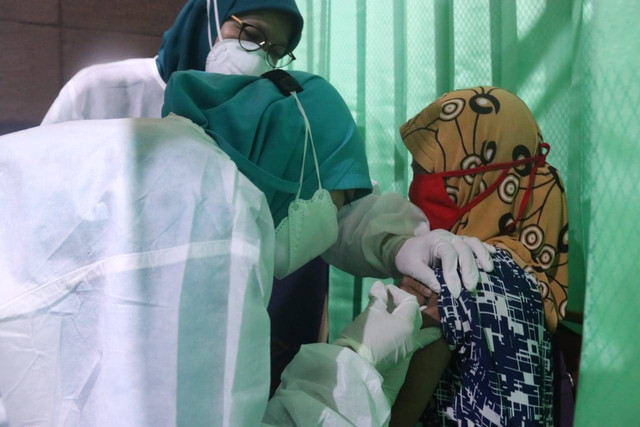Tentang KamiPedoman Media SiberKetentuan & Kebijakan PrivasiPanduan KomunitasPeringkat PenulisCara Menulis di kumparanInformasi Kerja SamaBantuanIklanKarir
2025 © PT Dynamo Media Network
Version 1.101.0
Konten dari Pengguna
Cases Of Health Law NO. 17 OF 2023 and Health Transformation In Indonesia
9 Januari 2025 17:14 WIB
·
waktu baca 7 menitTulisan dari Joyce Chew tidak mewakili pandangan dari redaksi kumparan
ADVERTISEMENT
Prepared by Group 8 (PDB INTERNATIONAL 2024)

CHAPTER I
INTRODUCTION
ADVERTISEMENT
1.1 Background
Health Law No. 17 of 2023, often known as the Omnibus Health Law, became effective on August 8, 2023. It is a key step in the reform of Indonesia's healthcare system. The law intends to improve health capacity, create a more productive workforce, decrease inequities, and strengthen healthcare services. It aims to provide a healthy living for all citizens while enhancing national welfare and competitiveness.[1] Despite medical practitioners' opposition, the Indonesian House of Representatives enacted the law on July 11, 2023. Its execution is expected to be critical in fulfilling Indonesia's national development objectives.
1.2 General Objectives
To thoroughly explore the broad implications of Health Law No. 17 of 2023, focusing on its role in reshaping Indonesia’s healthcare landscape. This involves analyzing how the law aligns with national health priorities, its contribution to the transformation of healthcare delivery systems, and its potential to address systemic challenges such as inequities, inefficiencies, and gaps in healthcare services.[2] The goal is to assess the law’s effectiveness in driving meaningful change and achieving improved health outcomes for the Indonesian population.
ADVERTISEMENT
1.3 Specific Objectives
To investigate and critically evaluate the various challenges and barriers that arise in the implementation of health transformation initiatives under Health Law No. 17 of 2023. This involves assessing factors such as institutional capacity, resource availability, stakeholder coordination, regulatory enforcement, and public awareness. By identifying these challenges, the study aims to provide a comprehensive understanding of the obstacles that hinder the law’s full potential.[3]
CHAPTER II
CASE DESCRIPTION
A prominent example of Health Law No. 17’s application is the initiative to integrate private and public healthcare facilities for achieving UHC. In 2024, a case in Jakarta highlighted the law’s effectiveness.[5] A collaboration between public hospitals and private clinics enabled efficient vaccine distribution to underserved areas. The initiative faced initial resistance due to concerns about resource allocation and operational alignment. However, through government-mandated coordination under the law, more than 90% of the target population received vaccinations within six months.
ADVERTISEMENT
CHAPTER III
CONCEPTUAL FRAMEWORK
The implementation of Health Law No. 17 of 2023 serves as the (independent variable), driving healthcare transformation outcomes such as improved access, reduced disparities, and enhanced service quality as the (dependent variable). (Mediating) this relationship are the six building blocks of health systems—governance, financing, service delivery, workforce, information systems, and medical products—which facilitate the law’s impact. (Moderating variables) like community engagement, regional differences, and stakeholder collaboration influence the strength of this impact, while (control variables), including population demographics, baseline healthcare quality, and external factors, ensure a clearer understanding of the law’s effects by accounting for other contributing influences.
CHAPTER IV
LITERATURE REVIEW
4.1 Overcoming Vaccine Hesitancy
Vaccine hesitancy is driven by three Cs: Complacency, Convenience, and Confidence. Overcoming hesitancy requires context-specific interventions, strengthening communication strategies, framing vaccination in a collective perspective, and tailoring messages to cultural, social, and individual concerns. The application of surveys and behavioral tools serves to understand the specific reasons for hesitancy and also to develop appropriate programs in improving vaccine uptake among under-vaccinated communities. [6]
ADVERTISEMENT
4.2 Equity and Social Justice in Public Health
Health equity and social justice, with a focus on the inequities in health that have been perpetuated through systemic racism and historical trauma. It states that access to health is not the solution; to achieve health equity, the very social determinants of health-which are discrimination and socioeconomic inequalities-must be addressed. Public health approaches should involve deep engagement with the experiences of marginalized communities, building trust to dismantle systems that perpetuate inequality. Social justice is necessary to assure equal opportunities for all to attain their full health potential. [7]
4.3 Community Engagement in Health Campaigns
It emphasizes the critical role of community engagement in health campaigns for vulnerable populations, which includes culturally sensitive messaging, active involvement of community members in the design of the campaign, and addressing structural barriers to healthcare. In this way, health campaigns can be tailored to meet the particular needs and values of these groups and, through collaboration, build trust in efforts to promote health equity and overcome disparities faced by marginalized communities. [8]
ADVERTISEMENT
CHAPTER V
DISCUSSION
5.1 Case Analysis
The Jakarta vaccination initiative demonstrates the potential of Health Law No. 17 in streamlining public-private partnerships. By defining roles and responsibilities, the law reduced fragmentation and improved service delivery efficiency. The Ministry of Social Affairs' initiative to ensure COVID-19 vaccinations for vulnerable groups in Indonesia reflects a critical aspect of equitable healthcare delivery.[9] Vulnerable populations, including people with disabilities, the elderly, and economically disadvantaged individuals, often face barriers in accessing essential healthcare services. By directly addressing these barriers, the Ministry demonstrated a proactive approach to public health, emphasizing inclusivity and community welfare.
5.2 Key Issues Identified
ADVERTISEMENT
5.3 Actions Taken
The Ministry of Social Affairs adopted a targeted approach to address these issues by:
The initiative succeeded in expanding vaccine coverage among vulnerable populations, thereby reducing health disparities and enhancing community resilience. Vulnerable groups who were previously overlooked were now given priority, exemplifying the government's commitment to public health equity. Additionally, the campaign fostered greater public trust in government health initiatives and strengthened collaborative frameworks for future health crises.
ADVERTISEMENT
5.4 Preventive Strategies
CHAPTER VI
CONCLUSION & SUGGESTION
Health Law No. 17 of 2023 is a cornerstone for advancing Indonesia’s healthcare system. The law’s emphasis on integration, equity, and accountability aligns with global best practices. However, addressing challenges such as resource disparities, workforce shortages, and public awareness is critical. Policymakers should focus on sustainable financing, robust training programs, and leveraging technology to ensure the success of health transformation initiatives. Continuous stakeholder engagement and policy refinement will be essential in realizing the law’s full potential for the benefit of all Indonesians.
ADVERTISEMENT
References
ADVERTISEMENT

